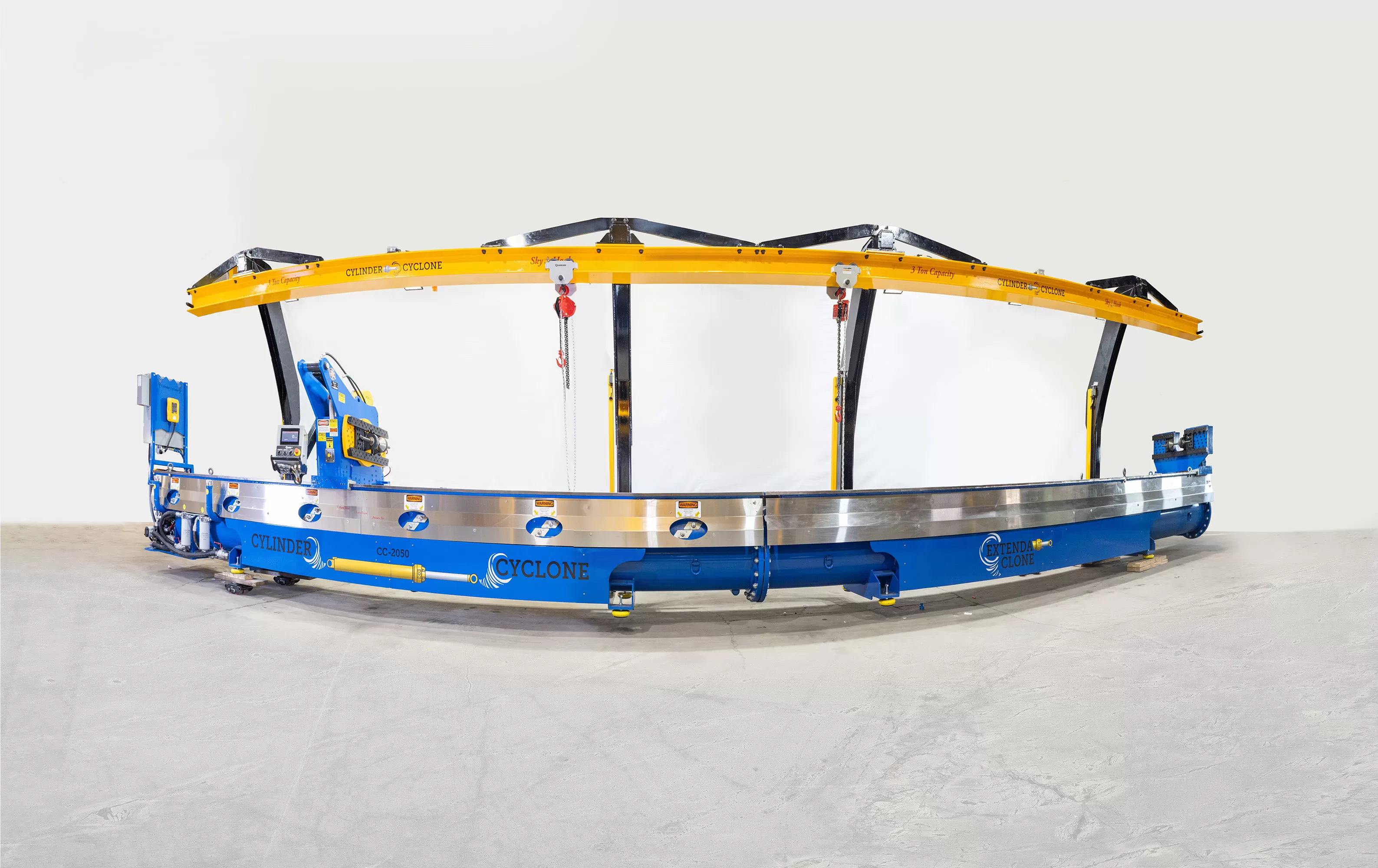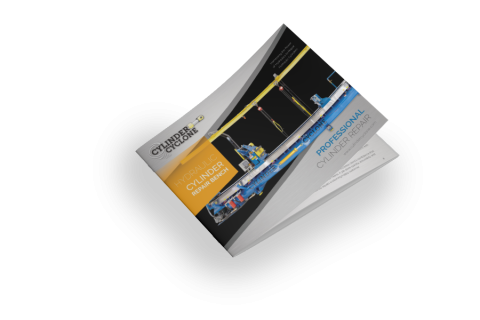
download
the brochure

Machine Specifications
Dimensions
25' 6" long, 54” wide, and 10’ 6” high (can be extended 12’ or 24’ longer with the ExtendaClone feature)
Weight
Approximately 13,000 lbs
Operating specifications
24”and 20’ center to center working length. Standard Cylinder Cyclone handles cylinders 24” diameter swing by 10’ long. Simple attachment available for shops that work with longer cylinders.
Oil capacities:
Main machine system – 30 gallons
Pressure test system – 55 gallons
Waste oil – 250 gallons
Motor
20HP 208/230/460V 3-phase motor or optional single phase 230V VFD
Large Capacities
The standard bench services cylinders up to 18” bore and 10’ long stroke. If all other cylinder components are removed from the bench, it is capable of removing a nut from a 20’ long rod. Add the optional ExtendaClone feature for an additional 6’ or 12’ of length capacities. Use the standard tailstock for up to 8” diameter rods, or the oversized tailstock for up to 15” diameter rods.
Free-standing unit
The entire unit is self-contained. It can be placed where it best serves your needs and moved whenever needed.
Bi-directional Torque Capability
Tighten with a torque of up to 37,500 ft./lbs. or loosen with up to 50,000 ft./lbs. (model CC-2050-CPB), or with 50,000 ft./lbs. of tightening torque and 60,000 ft./lbs. of loosening torque (model CC-2060-RPB)... simply at the push of a remote button!
Full Length Push/Pull Feature
Perform repairs and tests on cylinders smoothly and quickly. With full length non-stop travel, there is no need to reset anchor points or move components.
Simple, Safe Operation
No need to be exposed to dangerous situations. Wireless remote allows operator to stand clear of machine functions. Simple operator training achieves professional results.
Precision Torque Settings
Tighten all repaired cylinder settings to manufacturer’s specs with a digital display on touchscreen - no guesswork!
Multi-speed Torque Head Travel and Rotation with Adjustable Pressure
Choose the force and speed you need. Avoid thread damage.
Repairing and Servicing Hydraulic Cylinders
Hydraulic actuators and cylinders fill an important role in the fields of mining, construction and manufacturing. Hydraulic cylinders are able to move heavy objects quickly and efficiently and also provide a strong force in clamp applications.
But when cylinders begin to leak or bend or break down, the effects can be catastrophic and the repairs costly and timely. That is where Hydraulic Cylinder repair shops fill a vital role in the economic structure.
Hydraulic systems require at least five elements to function properly. There must be an oil reservoir into which the oil is taken and returned. Then there must be a pump creating pressurized oil that is then controlled by valves. There is a cylinder or a motor into which the oil is pumped in order to create the desired movement. And lastly, there is a system of piping and hoses that transport pressurized fluid to and from the individual load devices.The cylinders and motors are the parts that convert the pressurized oil into different kinds of motion. A essential element in the cylinder is the seals and bearings which keep the oil contained and allow controlled and precise motion. These seals and bearings that will eventually wear and break down. Servicing and replacing these components can be a messy job, with many hours of machine downtime. That is where hydraulic cylinder repair benches come into focus.
Common Hydraulic Problems
Since hydraulic cylinders require fluid under pressure in order to operate, keeping that fluid contained to the system is a common challenge for hydraulic systems. Problems such as extreme temperatures, erosion of seals due to particles in the fluid, misalignment, or corrosion will damage the hydraulic cylinder system and cause breakdown. When fluid starts to leak out of the system, the cylinder will not have the same power. Eventually, the entire hydraulic system will stop entirely. Below are some common sources that could result in a system leak.
Contaminated Hydraulic Fluid - The fluid in a hydraulic system is the lifeblood of the system and needs to be clean and clear of air and water. Hydraulic fluid does not mix with water and a mixture will damage unprotected components. Air in the cylinder or hoses is also a problem. While oil doesn’t compress, air certainly does, so when air gets into the hydraulic system, the air will compress, causing cavities to form in the pump or damage to the cylinders themselves. Small particles that escape through the filter can cause erosion to seals and moving components. This erosion, over time, will cause leakage.
Components out of alignment - A hydraulic cylinder is typically used to move objects, and it’s linked to other moving parts. When the cylinder extends, these other moving parts need to pivot and slide with the cylinder in perfect alignment. The rod of a cylinder is made of hardened material that should never bend, so when there is a misalignment, the seals will wear on one side causing premature failure.
Excessive Temperatures - Hydraulic seals in cylinders are designed to work efficiently at a specific temperature. If the oil rises above the designed temperature, the seals that prevent leakage could start to fail. This failure could result in a violent release of high-pressure hot oil.
Issues to Watch to Prevent Hydraulic System Failures
It will come as no surprise to you that the solution to preventing these common problems is to maintain your equipment and use it in the recommended environment, but there are additional ways to determine when these problem sources should be scrutinized.
Contaminants
Filters have a life span and should be changed on a regular basis, but there are conditions where a filter might need maintenance before the recommended end-of-life. By measuring pressure before and after the filter, control systems can monitor and report failing filters before they become a problem.
Temperature
As the temperature of the fluid rises, the elasticity of the seals can change and could cause leakage. Oil coolers are the best method for reducing the temperature of the fluid. If the system has temperature sensors, emergency shutdowns can take place and stop damage to the equipment.
Corrosion
The rod of many hydraulic cylinders is made of hardened steel with a chrome finish on the outside. This hard chrome plating is further ground to a very accurate dimension with tight tolerances. As the cylinder ages, the chrome plating will eventually wear off, and corrosion will start to occur on the rod, reducing the life of the cylinder. To prevent this common problem, perform regular visual checks on the equipment and look out for signs of corrosion or pitting of the cylinder rod.
Misalignment
Another source of corrosion, and ultimately damage to the overall system, comes from misalignments that cause more wear on one side of the rod vs. the other. Visually ensure that there are no scuff marks on the cylinder rod that indicate excessive friction, and look for uneven wear on the rod-eye or cap-end clevis.
Repairing The Cylinder
Unfortunately, repairing a cylinder isn’t as simple as replacing a severed wire or putting a new nut and bolt onto a bracket. The finishes and tolerances are so tight that they are often beyond the scope of simple repair equipment. Preventing problems by identifying future failure signs can be the most important part of the process: prevent the issue, then you won’t need to repair it.
Depending on the size and extent of damage to your cylinder, you might want to take it to an accredited repair shop. This is where the Cylinder Cyclone fills a unique spot as it easily and efficiently handles the disassembly/reassembly and testing of the cylinder.
Chrome plating damage or corrosion will require stripping away and replating of the surface, then grinding and polishing to very tight tolerances.
Physical damage due to misalignment (bent shafts) might require welding and machining, so a repair shop will be required if an in-house staff isn't available for such a repair.
Filters and regular oil changes can easily be done in the field in a timely manner, while other repairs will require the equipment to be shut down for some time. It's best to focus on the recommended preventive maintenance, as insignificant as it might seem, in order to prevent larger problems down the road.

